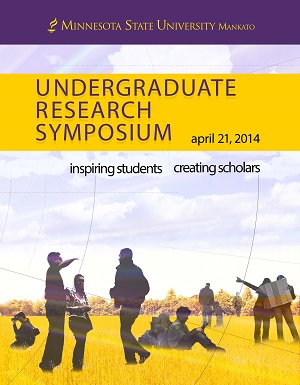Mapping the Spatial and Temporal Expression Pattern of Chst15 mRNA in the Cochlea of Euthyroid Mice Throughout Development
Location
CSU Ballroom
Start Date
21-4-2014 10:00 AM
End Date
21-4-2014 11:30 AM
Student's Major
Biological Sciences
Student's College
Science, Engineering and Technology
Mentor's Name
David Sharlin
Mentor's Email Address
david.sharlin@mnsu.edu
Mentor's Department
Biological Sciences
Mentor's College
Science, Engineering and Technology
Description
Hypothyroidism is a state or condition in which there is an insufficient amount of thyroid hormone production. Pregnant women with hypothyroidism, or children born with congenital thyroid disorders, are known to suffer from developmental and neurological dysfunctions such as deafness or mental retardation. Research has pinpointed a cell-dense area in the cochlea known as the greater epithelial ridge (GER) as a major site of thyroid hormone action. This region has the highest concentration of thyroid hormone receptors in the developing cochlea, indicating it is a target of thyroid hormone signaling. Screening for genes that are responsive to thyroid hormone in the GER identified carbohydrate (N-acetylgalactosamine 4-sulfate 6-O) sulfotransferase 15 (Chst15) as a candidate for thyroid hormone receptor target gene. Interestingly, Chst15 was recently identified as one of several genes missing in a large chromosomal deletion of a spontaneous deaf mouse line. Our research is aimed at mapping the spatial and temporal expression pattern of Chst15 mRNA in the cochlea of euthyroid mice throughout development and to determine whether the normal expression of Chst15 mRNA is disrupted following developmental hypothyroidism. To test this, we harvested cochlea from hypothyroid and euthryoid controls at postnatal days 1, 5, and 7. After cryosectioning, in situ hybridization, which detects the localization of mRNA in tissues, was completed. Preliminary results indicate that Chst15 expression decreases as development proceeds and that hypothyroidism delays this decrease. These results support Chst15’s involvement in proper cochlear development and implicates Chst15 as a potential deafness gene misregulated in hypothyroidism.
Mapping the Spatial and Temporal Expression Pattern of Chst15 mRNA in the Cochlea of Euthyroid Mice Throughout Development
CSU Ballroom
Hypothyroidism is a state or condition in which there is an insufficient amount of thyroid hormone production. Pregnant women with hypothyroidism, or children born with congenital thyroid disorders, are known to suffer from developmental and neurological dysfunctions such as deafness or mental retardation. Research has pinpointed a cell-dense area in the cochlea known as the greater epithelial ridge (GER) as a major site of thyroid hormone action. This region has the highest concentration of thyroid hormone receptors in the developing cochlea, indicating it is a target of thyroid hormone signaling. Screening for genes that are responsive to thyroid hormone in the GER identified carbohydrate (N-acetylgalactosamine 4-sulfate 6-O) sulfotransferase 15 (Chst15) as a candidate for thyroid hormone receptor target gene. Interestingly, Chst15 was recently identified as one of several genes missing in a large chromosomal deletion of a spontaneous deaf mouse line. Our research is aimed at mapping the spatial and temporal expression pattern of Chst15 mRNA in the cochlea of euthyroid mice throughout development and to determine whether the normal expression of Chst15 mRNA is disrupted following developmental hypothyroidism. To test this, we harvested cochlea from hypothyroid and euthryoid controls at postnatal days 1, 5, and 7. After cryosectioning, in situ hybridization, which detects the localization of mRNA in tissues, was completed. Preliminary results indicate that Chst15 expression decreases as development proceeds and that hypothyroidism delays this decrease. These results support Chst15’s involvement in proper cochlear development and implicates Chst15 as a potential deafness gene misregulated in hypothyroidism.
Recommended Citation
Nicholson, Andrew and Cari Graber. "Mapping the Spatial and Temporal Expression Pattern of Chst15 mRNA in the Cochlea of Euthyroid Mice Throughout Development." Undergraduate Research Symposium, Mankato, MN, April 21, 2014.
https://cornerstone.lib.mnsu.edu/urs/2014/poster_session_A/27



